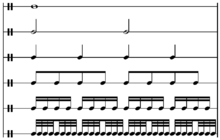Eighth note



| Drum pattern, accompanied by ride patterns of various duple lengths from | |||
An eighth note (American) or a quaver (British) is a musical note played for half the value of a quarter note (crotchet) and twice that of the sixteenth note (semiquaver), which amounts to one quarter the duration of a half note (minim), one eighth the duration of whole note (semibreve), one sixteenth the duration of a double whole note (breve), and one thirty-second the duration of a longa, hence the name. It is the equivalent of the fusa in mensural notation (Morehen and Rastell 2001)
Eighth notes are notated with an oval, filled-in note head and a straight note stem with one flag note flag (see Figure 1). A related symbol is the eighth rest (or quaver rest), which denotes a silence for the same duration.
In Unicode, the symbols U+266A (♪) and U+266B (♫) are an eighth note and beamed pair of eighth notes respectively. The two symbols are inherited from the early 1980s code page 437, where they occupied codes 13 and 14 respectively. Additions to the Unicode standard also incorporated additional eighth note depictions from Japanese emoji sets: ascending eighth notes (U+1F39C, 🎜), descending eighth notes (U+1F39D, 🎝), a graphical generic musical note generally depicted as an eighth note (U+1F3B5, 🎵), and three unconnected eighth notes in sequence (U+1F3B6, 🎶). Unicode's Musical Symbols block includes several variations of the eighth note; these are the versions intended to be used in computerized musical notation (as opposed to the others, which are graphical dingbats).
Eighth notes in 3
8, 6
8, 9
8, and 12
8 are beamed three eighth notes at a time. A single eighth note is always stemmed with a flag, while two or more are usually beamed in groups (Gerou 1996, p. 211).
| Look up quaver in Wiktionary, the free dictionary. |
See also
References
- Gerou, Tom (1996). Essential Dictionary of Music Notation. Alfred. ISBN 0-88284-730-9
- Harper, Douglas. 2010. "Quaver" Dictionary.com.
- Morehen, John, and Richard Rastall. 2001. "Quaver". The New Grove Dictionary of Music and Musicians, second edition, edited by Stanley Sadie and John Tyrrell. London: Macmillan Publishers.